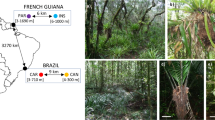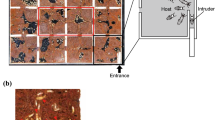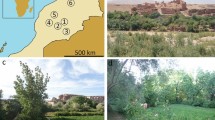Abstract
Colonies of the stingless bee Tetragonilla collina frequently occur in unusually high densities and in direct neighborhood (nest aggregations), in rainforests of Southeast Asia. To investigate whether close relatedness and/or similar chemical profiles facilitate the co-occurrence of multiple T. collina colonies, we investigated aggressive behavior, genetic relatedness and cuticular hydrocarbon (CHC) profiles within and between colonies and nest aggregations. Although 17 out of 19 colonies within aggregations were largely unrelated, intraspecific aggression between different colonies was basically absent both within and among aggregations. This lack of aggression should favor social parasitism and hence the occurrence of unrelated individuals within a colony. However, low within-colony relatedness was found in only five out of 19 colonies where it may be explained by queen turnover or the occurrence of foreign workers. CHC profiles of colonies within and among aggregations were statistically different. However, many workers could chemically not be assigned to their maternal colony, indicating considerable overlap among colonies in odor profiles of workers. Moreover, odor profiles tended to be more similar within than among aggregations, although most colonies were unrelated. Thus, CHC profiles were a poor indicator of relatedness in T. collina. The lack of correlation between relatedness and chemical similarity in T. collina may be explained by the incorporation of resin-derived terpenes in their CHC profiles. The composition of these terpenes was highly similar among colonies, particularly within aggregations, hence potentially decreasing chemical distinctiveness and increasing behavioral tolerance.

Similar content being viewed by others
References
Akino, T., Yamamura, K., Wakamura, S., Yamaoka, R. 2004. Direct behavioral evidence for hydrocarbons as nestmate recognition cues in Formica japonica (Hymenoptera : Formicidae). Appl. Entomol. Zoolog. 39:381–387.
Alves, D. A., Imperatriz-Fonseca, V. L., Francoy, T. M., Santos-Filho, P. S., Nogueira-Neto, P., Billen, J., Wenseleers, T. 2009. The queen is dead—long live the workers: intraspecific parasitism by workers in the stingless bee Melipona scutellaris. Mol. Ecol. 18:4102–4111.
Beekman, M., Oldroyd, B. P. 2008. When workers disunite: Intraspecific parasitism by eusocial bees. Annu. Rev. Entomol. 53:19–37.
Buchwald, R., Breed, M. D. 2005. Nestmate recognition cues in a stingless bee, Trigona fulviventris. Anim. Behav. 70:1331–1337.
Cameron, E. C., Franck, P., Oldroyd, B. P. 2004. Genetic structure of nest aggregations and drone congregations of the southeast Asian stingless bee Trigona collina. Mol. Ecol. 13:2357–2364.
Cardinal, S., Straka, J., Danforth, B. N. 2010. Comprehensive phylogeny of apid bees reveals the evolutionary origins and antiquity of cleptoparasitism. Proc. Natl. Acad. Sci. U. S. A. 107:16207–16211.
Châline, N., Sandoz, J. C., Martin, S. J., Ratnieks, F. L. W., Jones, G. R. 2005. Learning and discrimination of individual cuticular hydrocarbons by honeybees (Apis mellifera). Chem. Senses 30:327–335.
Chapuisat, M., Bernasconi, C., Hoehn, S., Reuter, M. 2005. Nestmate recognition in the unicolonial ant Formica paralugubris. Behav. Ecol. 16:15–19.
Clark, K. L., Robertson, R. J. 1979. Spatial and temporal multi-species nesting aggregations in birds as anti-parasite and anti-predator defenses. Behav. Ecol. Sociobiol. 5:359–371.
Cook, J. M., Crozier, R. H. 1995. Sex determination and population biology in the Hymenoptera. Trends in Ecology and Evolution 10:281–286.
Crozier, R. H., Dix, M. W. 1979. Analysis of two genetic models for the innate components of colony odor in social Hymenoptera. Behav. Ecol. Sociobiol. 4:217–224.
Dani, F. R., Jones, G. R., Corsi, S., Beard, R., Pradella, D., Turillazzi, S. 2005. Nestmate recognition cues in the honey bee: differential importance of cuticular alkanes and alkenes. Chem. Senses 30:477–489.
Downs, S. G., Ratnieks, F. L. W. 2000. Adaptive shifts in honey bee (Apis mellifera L.) guarding behavior support predictions of the acceptance threshold model. Behav. Ecol. 11:326–333.
Drescher, J., Blüthgen, N., Feldhaar, H. 2007. Population structure and intraspecific aggression in the invasive ant species Anoplolepis gracilipes in Malaysian Borneo. Molecular Ecology 16:1453–1465.
Dworschak, K., Blüthgen, N. 2010. Networks and dominance hierarchies: does interspecific aggression explain flower partitioning among stingless bees? Ecol. Entomol. 35:216–225.
Eltz, T. 2004. Spatio-temporal variation of apine bee attraction to honeybaits in Bornean forests. J. Trop. Ecol. 20:317–324.
Eltz, T., Brühl, C. A., Zamrie, I., Linsenmair, K. E. 2001. Nesting and nest trees of stingless bees (Apidae: Meliponini) in lowland dipterocarp forests in Sabah, Malaysia, with implications for forest management. Forest. Ecol. Manag. 5833:1–13.
Errard, C., Delabie, J., Jourdan, H., Hefetz, A. 2005. Intercontinental chemical variation in the invasive ant Wasmannia auropunctata (Roger) (Hymenoptera Formicidae): a key to the invasive success of a tramp species. Naturwissenschaften 92:319–323.
Excoffier, L., Laval, G., Schneider, S. 2006. Arlequin 3.1—An Integrated Software Package for Population Genetics data analysis. Evolutionary Bioinformatics Online 1:47–50.
Fox, J. D. 1973. A Handbook to Kabili-Sepilok Forest Reserve. Sandakan: Sabah Forest Department.
Getz, W. M., Chapman, R. F. 1987. An odor discrimination model with application to kin recognition in social insects. Int. J. Neurosci. 32:963–978.
Giraud, T., Pedersen, J. S., Keller, L. 2002. Evolution of supercolonies: the Argentine ants of southern Europe. Proc. Natl. Acad. Sci. U. S. A. 99:6075–6079.
Gonzalez, V. H., Ospina, M. 2008. Nest structure, seasonality, and host plants of Thygater aethiops (Hymenoptera : Apidae, Eucerini) in the Andes. Journal of Hymenoptera Research 17:110–115.
Green, C. L., Franck, P., Oldroyd, B. P. 2001. Characterization of microsatellite loci for Trigona carbonaria, a stingless bee endemic to Australia. Mol. Ecol. Notes 1:89–92.
Haeseler, V. 2008. On the biology of the Mediterranean mason bees Osinia batearica Schmiedeknecht 1885 and Osmia uncicornis Perez 1895 (Hymenoptera : Apidae). Abhandlungen Naturwissenschaftlichen Verein zu Bremen 46:289–300.
Helanterä, H. 2009. Do unicolonial wood ants favor kin? J. Biol. 8:56.
Holway, D. A., Suarez, A. V., Case, T. J. 1998. Loss of intraspecific aggression in the success of a widespread invasive social insect. Science 282:949–952.
Howard, J. J. 1985. Observations on resin collecting by six interacting species of stingless bees (Apidae, Meliponinae). J. Kans. Entomol. Soc. 58:337–345.
Howard, R. W. 1993. Cuticular hydrocarbons and chemical communication. pp. 179–226, in: D. W. Stanley-Samuelson, D. R. Nelson (ed.). Insects Lipids: Chemistry, Biochemistry and Biology. Lincoln, Nebraska: University of Nebraska Press.
Howard, R. W., Blomquist, G. J. 2005. Ecological, behavioral, and biochemical aspects of insect hydrocarbons. Annu. Rev. Entomol. 50:371–393.
Hubbell, S. P., Johnson, L. K. 1977. Competition and nest spacing in a tropical stingless bee community. Ecology 58:949–963.
Hubbell, S. P., Johnson, L. K. 1978. Comparative foraging behavior of six stingless bee species exploiting a standardized resource. Ecology 59:1123–1136.
Inoue, T., Sakagami, S. F., Salmah, S., Yamane, S. 1984. The process of colony multiplication in the Sumatran stingless bee Trigona (Tetragonula) laeviceps. Biotropica 16:100–111.
Inoue, T., Roubik, D. W., Suka, T. 1999. Nestmate recognition in the stingless bee Melipona panamica (Apidae, Meliponini). Insect. Soc. 46:208–218.
Johnson, L. K., Hubbell, S. P. 1974. Aggression and competition among stingless bees—field studies. Ecology 55:120–127.
Kirchner, W. H., Friebe, R. 1999. Nestmate discrimination in the African stingless bee Hypotrigona gribodoi Magretti (Hymenoptera : Apidae). Apidologie 30:293–298.
Kukuk, P. F., Bitney, C., Forbes, S. H. 2005. Maintaining low intragroup relatedness: evolutionary stability of nonkin social groups. Anim. Behav. 70:1305–1311.
Lacy, R. C., Sherman, P. W. 1983. Kin recognition by phenotype matching. Am. Nat. 121:489–512.
Landi, M., Coster-Longman, C., Turillazzi, S. 2002. Are the selfish herd and the dilution effects important in promoting nest clustering in the hover wasp Parischnogaster alternata (Stenogastrinae Vespidae Hymenoptera)? Ethol. Ecol. Evol. 14:297–305.
Leonhardt, S. D., Blüthgen, N. 2009. A sticky affair: resin collection by Bornean stingless bees. Biotropica 41:730–736.
Leonhardt, S. D., Blüthgen, N., Schmitt, T. 2009. Smelling like resin: terpenoids account for species-specific cuticular profiles in Southeast-Asian stingless bees. Insect. Soc. 56:157–170.
Leonhardt, S. D., Blüthgen, N., Schmitt, T. 2010a. Chemical profiles of body surfaces and nests from six Bornean stingless bee species. J. Chem. Ecol. 37:98–104.
Leonhardt, S. D., Jung, L.-M., Schmitt, T., Blüthgen, N. 2010b. Terpenoids tame aggressors: role of chemicals in stingless bee communal nesting. Behav. Ecol. Sociobiol. 64:1415–1423.
Leonhardt, S. D., Schmitt, T., Blüthgen, N. 2011. Resource composition, collection behaviour and selective filters shape chemical profiles of tropical bees. Plos One 6(8):e23445. doi:10.1371/journal.pone.0023445.
Lopez-Vaamonde, C., Koning, J. W., Brown, R. M., Jordan, W. C., Bourke, A. F. G. 2004. Social parasitism by male-producing reproductive workers in a eusocial insect. Nature 430:557–560.
Marsh, C. W., Greer, A. G. 1992. Forest land-use in Sabah, Malaysia: an introduction to Danum Valley. Philosoph. Trans. R. Soc. Lond. B 335:331–339.
Martin, S. J., Drijfhout, F. P. 2009. A review of ant cuticular hydrocarbons. J. Chem. Ecol. 35:1151–1161.
Martin, S. J., Vitikainen, E., Helanterä, H., Drijfhout, F. P. 2008. Chemical basis of nest-mate discrimination in the ant Formica exsecta. Proc. R. Soc. Lond. B 275:1271–1278.
Martin, S. J., Helanterä, H., Kiss, K., Lee, Y. R., Drijfhout, F. P. 2009. Polygyny reduces rather than increases nestmate discrimination cue diversity in Formica exsecta ants. Insect. Soc. 56:375–383.
Mcdaniel, C. A., Howard, R. W., Blomquist, G. J., Collins, A. M. 1984. Hydrocarbons of the cuticle, sting apparatus, and sting shaft of Apis mellifera L—identification and preliminary evaluation as chemotaxonomic characters. Sociobiology 8:287–298.
Michener, C. D. 1974. The social behavior of the bees. Cambridge: Belknap Press of Harvard University Press.
Moure, J. S. 1961. A preliminary supra-specific classification of the old world meliponine bees (Hymenoptera, Apoidea). Studia Entomologica 4:181–242.
Nagamitsu, T., Inoue, T. 1997. Aggressive foraging of social bees as a mechanism of floral resource partitioning in an Asian tropical rainforest. Oecologia 110:432–439.
Nunes, T. M., Nascimento, F. S., Turatti, I. C., Lopes, N. P., Zucchi, R. 2008. Nestmate recognition in a stingless bee: does the similarity of chemical cues determine guard acceptance? Anim. Behav. 75:1165–1171.
Paxton, R. J., Bego, L. R., Shah, M. M., Mateus, S. 2003. Low mating frequency of queens in the stingless bee Scaptotrigona postica and worker maternity of males. Behav. Ecol. Sociobiol. 53:174–181.
Pedersen, J. S., Krieger, M. J. B., Vogel, V., Giraud, T., Keller, L. 2006. Native supercolonies of unrelated individuals in the invasive Argentine ant. Evolution 60:782–791.
Peeters, C. P. 1988. Nestmate discrimination in a ponerine ant (Rhytidoponera sp. 12) without a queen caste and with a low intra-nest relatedness. Insect. Soc. 35:34–46.
Queller, D. C., Goodnight, K. F. 1989. Estimating relatedness using genetic markers. Evolution 43:258–275.
Raymond, M., Rousset, F. 1995. Genepop (Version 1.2)—Population genetics software for exact tests and ecumenicism. Journal of Heredity 86:248–249.
Reeve, H. K. 1989. The evolution of conspecific acceptance thresholds. Am. Nat. 133:407–435.
Roubik, D. W. 1989. Ecology and natural history of tropical bees. New York: Cambridge University Press.
Roubik, D. W. 1996. Wild bees of Brunei Darussalam. pp. 566, in: D. S. Edwards, W. E. Booth, S. C. Choy (ed.). Tropical Rainforest Research—Current Issues: Proceedings of the Conference Held in Bandar Seri Begawan, April 1993. Bandar Seri Begawan: Kluwer Academic Publishers.
Roubik, D. W. 2006. Stingless bee nesting biology. Apidologie 37:124–143.
Sakai, S., Momose, K., Inoue, T., Hamid, A. A. 1997. Climate data in Lambir Hills National Park and Miri Airport, Sarawak. pp. 1–10. in: T. Inoue, A. A. Hamid (ed.), General flowering of tropical rainforest in Sarawak: Center for Ecological Research, Kyoto University.
Satoh, T., Hirota, T. 2005. Factors affecting internest variation in the aggressiveness of a polygynous ant, Camponotus yamaokai. Entomol. Sci. 8:277–281.
Steiner, F. M., Schlick-Steiner, B. C., Moder, K., Stauffer, C., Arthofer, W., Buschinger, A., Espadaler, X., Christian, E., Einfinger, K., Lorbeer, E. et al. 2007. Abandoning aggression but maintaining self-nonself discrimination as a first stage in ant supercolony formation. Curr. Biol. 17:1903–1907.
Sumner, S., Lucas, E., Barker, J., Isaac, N. 2007. Radio-tagging technology reveals extreme nest-drifting behavior in a eusocial insect. Curr. Biol. 17:140–145.
Thiele, R., Inouye, B. D. 2007. Nesting biology, seasonality, and mating behavior of Epicharis metatarsalis (Hymenoptera : Apidae) in northeastern Costa Rica. Ann. Entomol. Soc. 100:596–602.
Timmermann, K., Kuhlmann, M. 2008. The biology of a Patellapis (s. str.) species (Hymenoptera : Apoidea : Halictidae): sociality described for the first time in this bee genus. Apidologie 39:189–197.
Tsutsui, N. D., Suarez, A. V., Holway, D. A., Case, T. J. 2000. Reduced genetic variation and the success of an invasive species. Proc. Natl. Acad. Sci. U. S. A. 97:5948–5953.
Ward, S. A., Kukuk, P. F. 1998. Context-dependent behavior and the benefits of communal nesting. Am. Nat. 152:249–263.
Wcislo, W. T. 1993. Communal nesting in a North American banded bee, Nomia tetrazonata, with notes on nesting behavior of Dieunomia heteropoda (Hymenoptera: Halictidae: Nomiinae). Ann. Entomol. Soc. 86:813–821.
Zayed, A., Packer, L. 2005. Complementary sex determination substantially increases extinction proneness of haplodiploid populations. Proc. Natl. Acad. Sci. U. S. A. 102:10742–10746
Acknowledgements
We thank the Economic Planning Unit (EPU) for giving us permission to perform research in Malaysia, and the Royal Society for their help with planning and conducting field work in Borneo. This project was further kindly supported by Dr. Chey Vun Khen, Dr. Arthur Chung and Dr. Robert Ong (Forestry Research Centre, Sandakan). Ben Oldroyd and Emilie Cameron provided additional data for comparison and validation of our results and Linda-Maria Jung helped with data collection. The comments of two anonymous reviewers greatly improved the manuscript. SDL was supported by a grant of the German Excellence Initiative to the Graduate School of Life Science, University of Würzburg, NB, HF and TS by the Sonderforschungsbereich SFB 554 (Mechanisms and Evolution of Arthropod Behaviour) of the Deutsche Forschungsgemeinschaft (DFG).
Author information
Authors and Affiliations
Corresponding author
Electronic supplementary material
Below is the link to the electronic supplementary material.
Figure S1
Similarity in chemical profiles of surface compounds from 14 Tetragonilla colonies of five nest aggregations in Borneo (ordination figure based on Bray-Curtis dissimilarities, stress value = 10.73 (note that stress values below 15 are generally accepted as reliable, see Backhaus et al 2003: Multivariate Analysemethoden. Eine Anwendungsorientierte Einführung. Springer, Berlin)). Different symbols represent different colonies (each symbol represents one individual bee): two colonies were collected from an aggregation in DVC (black and white upright ellipses) and four colonies from an aggregation found close to the coast in KSR (black and white ellipses, black and white triangles upside down). The remaining colonies stem from one aggregation in the interior forest of KSR (black diamonds, white circles, black and grey triangles), and two aggregations at the RDC (white diamond and black square as well as grey squares and black circles). Grey symbols mark two Tetragonilla spec. colonies (grey triangle and square) that are morphologically highly similar to T. collina, but strongly differ in their chemical profiles. These colonies most likely represent another Tetragonilla species and were thus excluded from further analyses. (PPT 136 kb)
Figure S2
Chromatograms of body surfaces from individual bees. Hexane extracts of two T. collina bees (a & b) and one Tetragonilla spec. (c) from nest aggregations in the RDC. Chemical differences between the two species are primarily based on esters and germacrene-D. (PPT 263 kb)
Table S1
(DOC 71 kb)
Table S2
(DOC 179 kb)
Rights and permissions
About this article
Cite this article
Leonhardt, S.D., Form, S., Blüthgen, N. et al. Genetic Relatedness and Chemical Profiles in an Unusually Peaceful Eusocial Bee. J Chem Ecol 37, 1117–1126 (2011). https://doi.org/10.1007/s10886-011-0016-3
Received:
Revised:
Accepted:
Published:
Issue Date:
DOI: https://doi.org/10.1007/s10886-011-0016-3




